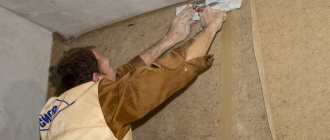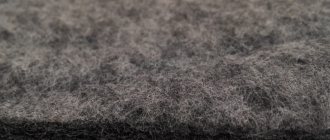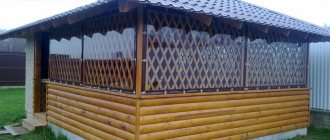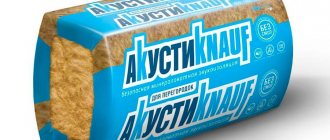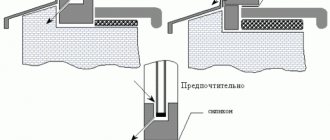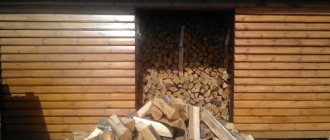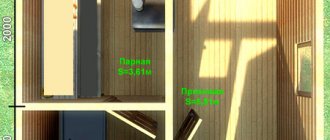Plastic windows are a modern standard in housing construction. New technologies have made it possible to eliminate all the shortcomings that the first models had and were inferior to wooden windows. A high-quality plastic window has virtually no disadvantages. It will never dry out or swell, it does not need to be painted. Due to the aesthetics of the design, the entire house acquires a stylish and neat appearance, and various ventilation systems and convenient mosquito nets completely solve the issue of air exchange.
But there is one point that can spoil the impression of a new window - an incorrectly installed visor or ebb. When it rains, when drops fall on the structure, there is such a roar that it is impossible to rest properly. Some may think that this is an insignificant minus, but only until you try to sleep to a drum orchestra.
How to solve the problem? Our article is devoted to answering this question.
“Sounding” window tint or visor is a problem that harms home comfort
Introduction
An integral part of the window block is the external ebb, which protects the installation seam from the street and gives the finished aesthetic appearance of the windows from the outside. Since this part is made mainly of steel or aluminum, during rain, hail or melting snow, the sound of drops on the ebb can greatly disturb the residents of the house. The “sound of music” can be endless on dull autumn nights, and consequently interfere with sleep.
How to deal with this? We hope this article will help you if you have this problem in your home.
Company advantages
- Freeze on the first day!
- We work 24/7
- 18 years of work
Still have questions? Leave a request and we will contact you shortly:
Listen to it without Gerden:
Ensuring low tide noise insulation during construction
First of all, to ensure that the ebb or visor does not make sounds during rain or strong gusts of wind, during the construction period the developer or installers installing window units must follow several rules, if correctly implemented, the sound insulation of the ebb will increase several times .
So, the first rule is to choose the right material thickness. Let us repeat that external drains are made mainly of steel or aluminum, and the resonating effect of the product made from them depends on the thickness of these materials. The thinner the steel (or aluminum), the greater the diaphragm effect the visor or shimmer has. And vice versa, the thicker and more massive the material, the greater its ability to both reflect and absorb sound waves.
Secondly, it is necessary to select the optimal width of the canvas, since it should not protrude too much from the wall of the house. The maximum permissible indentation of the decorative element in question is considered to be 2-3 centimeters, which, given the optimal area exposed to the effects of natural elements, reduces the noise level of this impact.
And finally, the most effective way to reduce noise from external drains or canopies is to use additional installation materials. These can be full-butyl tapes, which are glued to the back of the ebb (or the outer part of the canopy) and PSUL, which is glued in a strip to the slope, preventing the drumming effect of the ebb on the slope of the window block.
How to reduce noise from the street in an apartment?
Of course, high-quality plastic windows with more than three cameras are a prerequisite on the path to silence. But there are also other considerations...
If the apartment room has a balcony or loggia, this already solves half the problem. Glazing a balcony/loggia helps to minimize noise almost completely, at least in a single room. The air cushion between the balcony windows and the room windows dampens sound vibrations.
Ideally, of course, you would need to create a vacuum between the layers of glass or windows, but this is not possible to do at home. If we remember physics, we know that sound travels faster in a dense medium. Sound does not travel in a vacuum. From this we can judge that if the air is cold, the molecules travel sound waves faster. It’s just that an air cushion with an ambient temperature higher than the outside temperature (in winter, for example) will transmit sound worse.
The same can be done with other rooms. Only on the other side - from the inside. As far as the window sill allows (the protrusion of the wall into the room from the standard installed frame), you can install a second window, and it does not have to be two or three chambers, it is important that it is dense. You will get the same “cushion” for sound dampening. The slopes inside (between the frames) can be finished with sound-absorbing materials.
Forest plantings provide excellent, albeit seasonal, sound insulation. Between our house and the railway, the distance is about a kilometer, you understand - trains are not luxury cars - the noise is terrible. When the house was built, two rows of poplar trees were planted in a checkerboard pattern, across the road from the house, between us and the railroad. In the summer, when the leaves bloom, you can hardly hear the iron, although in winter and especially in frosts, everything is exactly the same as it was, but we are grateful even for six months of peace.
Blinds on windows are also good sound insulation. They serve as another barrier to sound vibrations.
If you approach this issue comprehensively - internal soundproofing of walls, additional glazing with high-quality double-glazed windows, sound-absorbing wallpaper in the room, this will certainly give results.
Soundproofing low tide yourself
Let us repeat that the most effective method of suppressing noise from external drain elements is to apply butyl tape along the entire length of the installed drain. And, if it so happens that when installing window units in your home, the installers were not concerned about ensuring that the tide was silent, then you can fix this problem yourself. To do this, you need to purchase a special metallized full-butyl tape and glue it to the ebb and visor, if you have one.
The three- to four-millimeter butyl-rubber composition of the adhesive material will guarantee maximum protection from vibrations and noise transmission by the ebb, since its dense structure and heavy mass will block the cutting of the ebb in strong winds or from the impact of raindrops. And the foil coating will additionally provide thermal protection to the window unit if the back part of the ebb is covered with tape, or, conversely, will reflect direct sunlight if the outer part of the additional elements is glued.
A knock on the window sill. How to remove noise?
Have a nice day everyone!
Given: Double-glazed windows with steel tints. The rain hits them very rhythmically, which saddens the household. Task: Remove or minimize this noise.
The difficulty is that dismantling is now hardly possible (for technical reasons).
Maybe you can glue something on top so that the sound from the impact of a drop is not so sharp?
I would be grateful for any practical advice.
BEARDY wrote: Maybe you can glue something on top,
Glue guerlain (butyl rubber tape) to the bottom. Find out what it is using Yandex or Google.
BEARDED wrote: Double-glazed windows with steel tints.
Better material type (automotive vibration insulation, sold in auto soundproofing studios and auto stores. All-weather, especially for vibration insulation (drop impacts)). Guerlain is a material for sealing interpanel joints.
I used 2mm vibproplast silver all over myself - it turned out just wonderful. I also gave it to a friend (he went crazy from the sounds). Before that, some kind of crap was glued from the very beginning. There is also super bimast or bimast bombs (4mm) - but they are very heavy (and more expensive) - the ebb can simply go away
Yes, and glue it underneath. z.y. I really want to do the same for all my neighbors now.
And I close the window when it rains. It's not summer anymore. No knock is heard. The window was installed well. No noise!
Viktor__s wrote: Better material like vibroplast
in a nutshell - it's the same thing, only guerlain is cheaper
Viktor__s wrote: Guerlain is a material for sealing interpanel joints.
And also: Guerlain is used for sealing interpanel joints in residential and industrial construction, in the aviation and automotive industries, and when installing roofs using polymer membranes. When using EPDM or EPDM membranes, the problem is the quality of the overlap. Special adhesives, if used at all, are very expensive. The use of 2-sided self-adhesive Guerlain tape, which has excellent adhesion to this type of membrane and durability of more than 25 years, helps solve this problem. Leaks in pitched roofs are the most common problem, especially in the spring. When installing new roofs made of sheet material (tin, copper, etc.) using Guerlen tape sealant, it eliminates the possibility of leaks in the roof structure. During emergency roof repairs, Guerlen-FA material, which has aluminum foil as a protective layer, is widely used. Guerlain was developed for sealing suspended ventilated facades, the service life of which is 50 years of operation in the average climate of Russia, which is confirmed by tests carried out by the Research Institute of Building Physics. In 2005, a system of sealing materials based on Guerlain was developed for the installation of window systems in accordance with GOST 30971-2002.
There are many similar materials - choose any with a film of butyl rubber or bitumen of at least 1.5-2mm" >
Low tide self-soundproofing technology
In order to independently provide the external decorative elements of the window with sound insulation, it is necessary to first dismantle the previously installed sills and canopies.
Next, the removed elements should be degreased so that the butyl rubber-based tapes can easily attach to their surface. Tapes, matched to the width of the ebb, are cut into strips of the required length and glued to the back side of the ebb and the outer side of the visor.
And finally, the elements treated in this way are attached back to the slopes using special polymer soundproofing dowels.
In the end, we can draw the following conclusion: if the developer, when installing windows, did not bother about soundproofing the external parts of the window structures of your house, and the sounds of beating drops or gusts of wind prevent you from sleeping peacefully, then this problem can be eliminated on your own or with the help of specialists, but with minimal financial costs.
How to cover the roof and balcony canopy so that they do not make noise?
The inconvenience is that there is no universal material on our market to solve this problem. As a result of 10 years of work experience, we can say that the most logical and convenient material was one that has the following properties:
- It should be a good, durable roofing material, such as bitumen, so that it can withstand nature's surprises.
- It should have sufficient thickness, provide good sound insulation of the balcony and not be too heavy.
- It should attach well, reliably and simply, ideally stick to any surface.
- This material should be easy to install for the climber, given that the work is carried out in weight and not be massive. For example, something like very flexible meter-long bitumen strips of different widths with increased sound insulation properties, which can be glued in a simple way to different roofs.
Unfortunately, no one has yet come up with such a universal target material, and for soundproofing balconies and balcony canopies, we use various roofing materials, automotive, etc., which are often massive, inconvenient to use, they need to be cut and we have to figure out how to fasten them. Often people do their own research, buy the material they think is best for thermal insulation, and then simply ask climbers to reinforce it on top. Sometimes when descending along the balconies you come across other options, like other climbers or the residents themselves did soundproofing.
We've seen this stuck on a visor or stem :
- Styrofoam
- Linoleum
- Rubber bath mats
- Artificial turf
- Automotive anti-gravel sprayed from a can
- Polyurethane foam poured over the entire extension area
- Expanded clay pebbles sprinkled on some kind of glue
- Just glued pieces of rubber from old inner tubes, etc.
And everyone is happy and says that it helped them. As you can see, there are many options and perhaps you can come up with something better...
Requirements for soundproofing materials
You can make a soundproofing finish for an iron roof using various materials. There is no universal remedy; each case requires an individual approach. Main selection criteria:
- Strength. The product must maintain its integrity under mechanical stress.
- Lack of response to changes in humidity levels and temperature changes.
- Resistance to ultraviolet radiation. The material must not decompose or release toxic substances when heated.
- A product of sufficient thickness will help make the balcony silent.
- A simple and reliable fastening can facilitate the process of soundproofing a roof.
Fulfillment of all conditions will ensure the reduction or complete disappearance of sounds from rain and wind.
How to remove stains and whiten a plastic window sill
Modern windows are beautiful and practical. They do not require special care, insulate the apartment from noise and retain heat. But no matter how carefully you treat the metal-plastic structure, over time, smudges and yellowing appear on it. Then every housewife begins to look for a method on how to clean a plastic window sill from stains so that it becomes like new again.
- What are the types of stains on the windowsill?
- What you need for cleaning
- Which purchased products are best to use?
- Effective folk methods
- How to wash plastic after repair
- Gentle care: the basic rule of a clean window sill
What are the types of stains on the windowsill?
To avoid having to think longer about how to remove stains from plastic window sills, wipe the dust off them daily with a dry soft cloth and wash them once a week with water and some cleaning products.
- To eliminate light stains, dissolve a spoonful of dishwashing gel or a little regular powder in 1 liter of warm water.
- Stir thoroughly until foam forms, soak a sponge in it and walk along the windowsill.
- Then remove the foam with a damp cloth and wipe the surface dry.
When a room or kitchen undergoes renovation, the question of how to clean a plastic window sill from stains and dirt becomes more pressing. Dust and construction dirt accumulate on it in huge quantities, and serious means are needed to remove it.
Most often, housewives encounter the following marks on the surface of the window sill:
- yellow blots left after watering flower pots;
- traces of grease and stubborn stains from dirt and rust;
- contamination from glue or adhesive tape;
- frozen drops of primer, polyurethane foam and stains from other repair work.
If there is a child in the house, most likely you will need a product on how to remove stains from a plastic window sill from crayons, markers or pencils.
What you need for cleaning
The surface of window sills varies. Smooth plastic can simply be washed with a regular microfiber sponge or fleece cloth. But if the texture of the window sill is porous or rough, small particles of dust get stuck in it and are more difficult to wipe off. Use a stiff sponge or brush.
Do not use metal scrapers or abrasive materials for cleaning; they leave behind micro-scratches that spoil the appearance of the window sill and collect various dirt.
A large amount of dirty residue usually collects in the cracks under the frame, and it is difficult to soak it and remove it with a simple sponge. How to clean plastic from stains in hard-to-reach places? Take a toothbrush that has become unusable, wet its bristles with water, scoop up the cleaning agent with them, thoroughly treat the surface and rinse off the powder.
Which purchased products are best to use?
Before you remove stains from a plastic window sill, you need to choose an effective product. Modern household chemicals offer a huge selection in this area.
- Proper. The universal product is sold in liquid and powder form. The composition of the drug is ideal for washing a plastic window sill. Dilute 3 tbsp. l. powder in 5 liters of warm water, stir, wipe the contaminated surface and do not forget to rinse the composition with clean water afterwards.
- Cillit Bang. The product has a pungent odor. It is sprayed onto the plastic, wiped with a sponge, left for a quarter of an hour and removed with a damp cloth. This cleaning removes yellow water stains, coffee stains and other household stains well.
- "Domestos". With its help, you can not only solve the problem of how to wash a plastic window sill from stubborn stains, but also whiten its surface. Apply the substance to a washcloth, scrub the white plastic thoroughly with it, leave for 15 minutes to soak the dirt, and rinse with water. This method can easily get rid of stubborn rust marks.
- "Sanita." It dissolves grease from the windowsill well, although it has a pungent odor. Apply the gel to the surface, rub it over all corners of the window sill, especially carefully treating greasy blots, and after half an hour, remove the product with water and a rag.
- "Pemolux". This gentle cream is suitable for cleansing fresh, small stains. Apply it to the stain, rub it with a dry cloth and, if the stain is not removed, repeat the procedure again.
- Cosmofen 10. This is a drug for those who need to wipe off complex old stains from a plastic window sill. Apply the composition to a napkin, clean the dirt with it and wash the windowsill with water. The drug is toxic, so wear a respirator and ventilate the room after treatment.
Important! Don't forget to wear rubber gloves when using caustic products to avoid damaging your hands.
Effective folk methods
When children or people with allergies live in an apartment, the question of how to wash stains on a plastic window sill is very pressing. Chemicals are not suitable for them, so it is better to pay attention to effective folk methods. Among the available tools you will find useful:
- household soap;
- soda;
- chalk or tooth powder;
- food vinegar.
The easiest way to clean a plastic window sill from yellow stains is with a soap solution. Mix 50 g of household goods in 1 liter of hot water. soap and wash the white plastic with this liquid as thoroughly as possible. Yellow marks, which often appear from water and soot, will disappear without a trace.
How to clean a window sill from yellow stains and whiten it with chalk or dental powder?
- Grind the chalk into dust, measure out 1 tbsp. l. product and pour a little water into it. You should get a homogeneous paste.
- Apply it to the windowsill, rub gently and rinse with water.
- Tooth powder is used in the same way.
Old stains can be scrubbed off with a mixture of baking soda and vinegar. Sprinkle baking soda on the dirt, soak a cloth in vinegar, blot the stained area with it, clean and rinse with water. When using this method, be careful not to leave the baking soda on the plastic for more than 5 minutes. It tends to eat away color, so white spots may form on the windowsill that differ from the main shade of the plastic.
Yellow stains from flower pots can be treated with hydrogen peroxide and after 2-3 minutes, wash the surface with water.
How to wash plastic after repair
During repairs, all people try to protect the window and window sill from dirt. But sometimes blots of primer or polyurethane foam end up on the plastic. How to remove stains on a plastic window sill after construction work?
- First of all, remove the plugs to prevent dust from accumulating in them, and sweep away all debris with a dry cloth.
- Then wash the window sill with soapy water or powder.
- If you need to know how to clean a plastic window sill from stains and dirt from primer or plaster, use cleaning products with mild abrasive substances.
- Treat the stain with the desired gel or cream and wait a few minutes.
- Using a rubber spatula, carefully pry up the softened primer and wash the window sill with clean water.
Polyurethane foam is difficult to clean. If it has dried out, cut off the top with a sharp knife, and generously apply Sanita or another strong preparation to the remains. After 30 minutes, the foam will be saturated, become softer, and it can be removed with a spatula, and the remains can be scraped off with a hard-bristled brush.
When you need to remove yellow stains from tape or glue from a plastic window sill, try White Spirit. Soak a cotton swab in it, gently wipe the sticky area and immediately rinse it with water. Use solvent with caution; some types of plastic may turn slightly yellow when in contact with it.
Gentle care: the basic rule of a clean window sill
So that you don’t have to spend a long time looking for something to remove stains on plastic, remove dirt before it has time to become embedded in the material. Fresh blots can be easily wiped off with a damp sponge and soap.
- After using household chemicals, do not forget to rinse the surface with plenty of water. This will get rid of streaks and prevent yellowing from appearing.
- For cleaning, use only products designed for plastic.
- Do not place hot dishes on plastic; traces of it are almost impossible to remove.
- It is advisable to place oilcloth napkins under flower pots. This will decorate the kitchen and room, and protect the window sill from smudges.
Children's drawings with crayons, pencils or markers are removed with a melamine sponge. You just need to moisten it with water, squeeze it lightly and wipe the stained area.
If you cannot use anything to clean the plastic window sill from yellow stubborn stains or scratches appear on it, call a plastic window service specialist. A professional will quickly polish the surface of the window sill and get rid of old dirt.
News
How to clean a plastic window sill from rusty stains
On the eve of the holiday, housewives put on a spree: among other things, they wash plastic windows until they are white. One of the most difficult stains is rust stains. They usually appear under flower pots. How to clean a white plastic window sill from rusty stains, read in this article - we have collected the best recipes from experienced housewives.
How to clean a plastic window sill from rust using improvised means
First of all, housewives try to get rid of stains using improvised means. Let's start with them.
Many people advise cleaning plastic window sills from rust with hydrogen peroxide. Hydroperite is diluted with water 1:1 and the surface is rubbed with this composition. This method is suitable for smooth window sills - they should not be rubbed with abrasives to prevent microcracks in the coating.
An important point: first try on the lower part of the window sill to see how the plastic reacts to liquid. If suspicious stains appear, it is better to use another folk method or a specialized remedy.
Window sills with a rough surface are scrubbed with baking soda or soda ash. But they do not take a dry mixture, but a slurry - dilute the powder with water or hydrogen peroxide. By the way, these compositions also remove stains from coffee and tea leaves - some housewives shared that they water the flowers with tea or coffee to feed them. And along with rust, tea and coffee traces often appear.
Another available method is Sif cleaning agent with a whitening effect. It is quite liquid, so it will not damage the window sill. You can apply it with special wipes for car panels - they will not scratch even smooth plastic.
What are the benefits of specialized cleaning products for plastic windows?
If folk methods and improvised means do not help, the last thing left is to buy a specialized cleaning composition. They are designed to minimize unwanted reactions on the plastic surface. Therefore, you can safely apply it to the windowsill.
Another advantage of special compounds is that they work as antistatic agents. And dust will not settle on the treated window sill as intensively.
How to clean a plastic window sill using a melamine sponge
Housewives praise this “tool” vying with each other. Melamine sponge copes well with difficult stains and rust is no exception. To remove a stain, you don’t even have to use a cleaning agent—the sponge effectively removes any traces.
The only disadvantage of this method is that the sponge does not last long - during the washing process it crumbles. But one is enough to clean the entire window - not only the window sill, but also the frames.
It is not recommended to wipe glass with melamine sponges - stains will remain.
